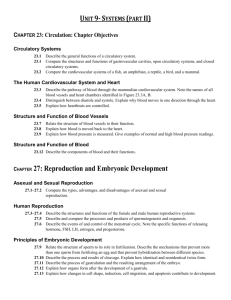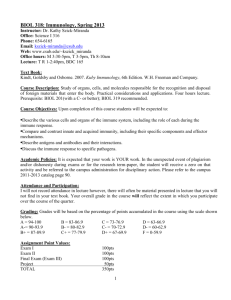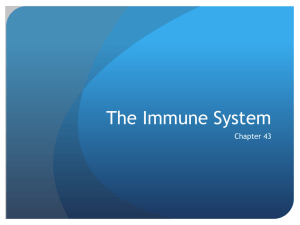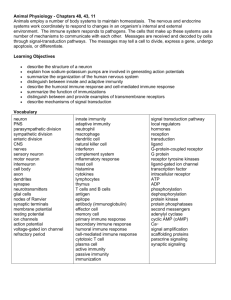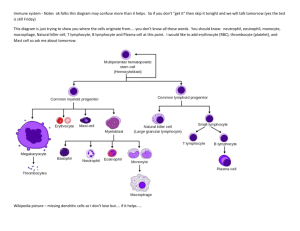Immune System Investigation Name Use Chapter 12 in your
advertisement
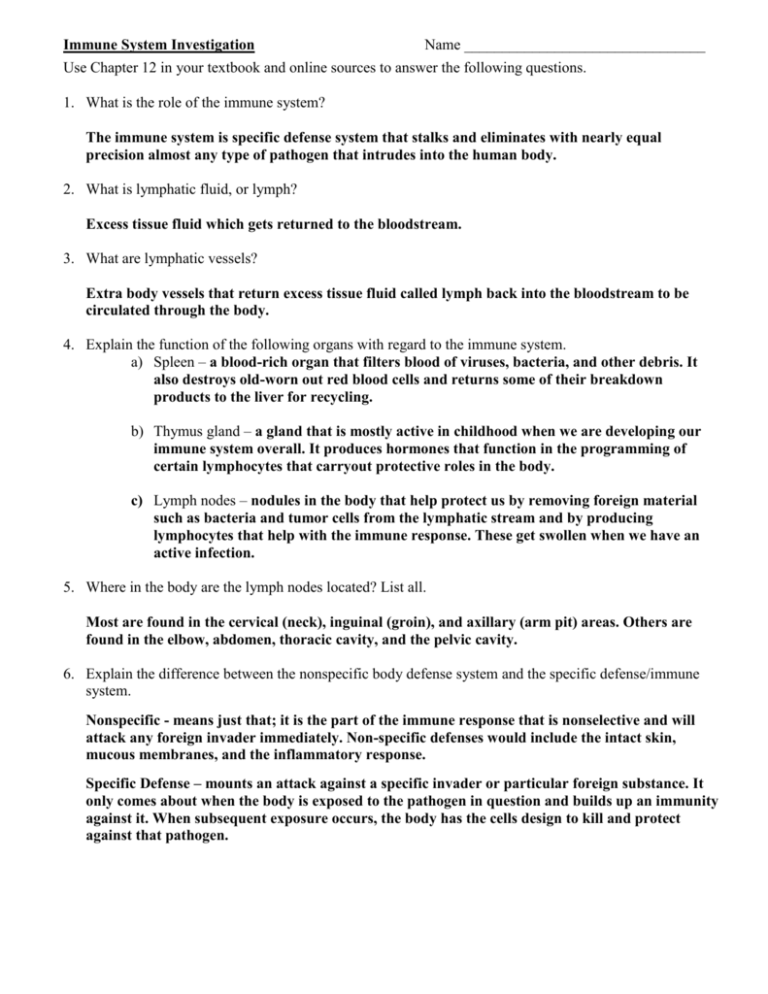
Immune System Investigation Name ________________________________ Use Chapter 12 in your textbook and online sources to answer the following questions. 1. What is the role of the immune system? The immune system is specific defense system that stalks and eliminates with nearly equal precision almost any type of pathogen that intrudes into the human body. 2. What is lymphatic fluid, or lymph? Excess tissue fluid which gets returned to the bloodstream. 3. What are lymphatic vessels? Extra body vessels that return excess tissue fluid called lymph back into the bloodstream to be circulated through the body. 4. Explain the function of the following organs with regard to the immune system. a) Spleen – a blood-rich organ that filters blood of viruses, bacteria, and other debris. It also destroys old-worn out red blood cells and returns some of their breakdown products to the liver for recycling. b) Thymus gland – a gland that is mostly active in childhood when we are developing our immune system overall. It produces hormones that function in the programming of certain lymphocytes that carryout protective roles in the body. c) Lymph nodes – nodules in the body that help protect us by removing foreign material such as bacteria and tumor cells from the lymphatic stream and by producing lymphocytes that help with the immune response. These get swollen when we have an active infection. 5. Where in the body are the lymph nodes located? List all. Most are found in the cervical (neck), inguinal (groin), and axillary (arm pit) areas. Others are found in the elbow, abdomen, thoracic cavity, and the pelvic cavity. 6. Explain the difference between the nonspecific body defense system and the specific defense/immune system. Nonspecific - means just that; it is the part of the immune response that is nonselective and will attack any foreign invader immediately. Non-specific defenses would include the intact skin, mucous membranes, and the inflammatory response. Specific Defense – mounts an attack against a specific invader or particular foreign substance. It only comes about when the body is exposed to the pathogen in question and builds up an immunity against it. When subsequent exposure occurs, the body has the cells design to kill and protect against that pathogen. 7. The first line of body defense includes the skin and mucous membranes. Give examples of how skin and mucous membranes provide mechanical and chemical barriers to infection. Mechanical: keratinized epidermis and mucous membranes form a strong physical barrier to many microorganisms. Chemical: acid pH of skin inhibits bacterial growth; vaginal secretions are also acidic; The stomach secretes hydrochloric and enzymes that kill pathogens; saliva and tears contain lysozyme which kills bacteria; and mucous forms a sticky trap for many microorganisms. 8. What is the role of the phagocytes? Specialized cells that engulf foreign particles (allergens, bacteria, viruses, etc.) to destroy them and prevent the spread of disease or destruction to body cells. 9. Explain what happens during the inflammatory response? It occurs in response to body injury from physical trauma, intense heat, and irritating chemicals. It is a non-specific response comprised of four stages: inflammation and redness, heat, swelling, and pain. It starts with a chemical alarm which causes blood vessels to dilate and become leaky. Pain receptors are activated, and phagocytes are attracted to the area through chemotaxis to engulf any foreign particles. 10. How does having a fever aid the immune system during an infection? The higher body temperature inhibits the multiplication of bacteria and enhances the body repair process. 11. Describe the following three important aspects of the immune response: a. It is antigen specific – it recognizes and acts against a particular pathogen or foreign substance. b. It is systemic – Immunity is not restricted to the initial infection site. It goes to the whole body. c. It has “memory”- it recognizes and mounts an even stronger attack on previously encountered pathogens because they have built an immunity against it. 12. What is an antigen? What is its role in the immune response? An antigen is any substance capable of exciting our immune system and provoking an immune response. Its role is in specific defense immunity, because pre-exposure leads to the formation of antibodies to prevent later infections. 13. What is an antibody? What is its role in the immune response? An antibodies or immunoglobulins are soluble proteins secreted by activated B cells in responses to an antigen. They are capable of binding specifically with an antigen to prevent disease. 14. What is a vaccine? Explain how vaccines work. A vaccine is an artificial way (injection, nasal liquid, etc.) to acquire immunity to a disease or pathogen. Often vaccines contain modified-live or killed viruses to initiate antibody formation by B cells and thus prevent future infections. 15. Lymphocytes are white blood cells that carry out the specific defense/immune response. Describe the functions of the following: a. B lymphocytes – b cells reside in the lymph nodes, spleen, and other lymphoid tissues; they play a role in building immunity against foreign invaders to prevent future infection. Produce antibodies and oversee humoral immunity. b. T lymphocytes – non-antibody producing cells that constitute the cell-mediated arm of immunity; major players in killing foreign cells and tumor cells. 16. What is the difference between humoral/antibody mediated immunity and cellular/cell mediated immunity? Humoral immunity is immunity provided by antibodies released by sensitized B cells and their plasma cell progeny. Cell-Mediated immunity is immunity made possible by lymphocytes called T cells to kill off tumor cells and foreign invaders. 17. What is the special role in the immune system of the Helper T cells/lymphocytes? Helper T cells are lymphocytes that stimulate the production of other immune cells and orchestrate cell mediated immunity by direct contact with other immune cells and by releasing chemicals called lymphokines; also play a role in humoral response by interacting with B cells. 18. Both viral and bacterial infections can make humans sick. Briefly describe the following: A. Viral sexually transmitted infections a. HIV – a retrovirus (RNA virus) that can lead to AIDS and specifically targets T cells of immune system resulting in total annihilation of our immune defenses. b. HPV – Human Papilloma Virus – A STI virus that can lead to cancer in the reproductive organs of both males and females. Very common and lots of people contract this virus. c. Herpes simplex I – aka Oral Herpes; is a virus that affects the mouth and lips leading to cold sores or fever blisters. Spread through saliva via kissing, sharing drinks, etc. d. Herpes simplex II – aka Genital Herpes; is a sexually transmitted virus that causes sores around the genitals or rectum. e. Hepatitis C – a virus that causes liver inflammation and long term liver damage; no current vaccine exists. Contagious disease spread through contact with infected blood. B. Bacterial sexually transmitted infections a. Chlamydia – most common STI in the US; a sexually transmitted bacteria that often does not have symptoms and is easily treated; can cause vaginal or penile discharge, painful intercourse, and other symptoms if advanced. b. Gonorrhea - is a sexually transmitted disease (STD) that can infect both men and women. It can cause infections in the genitals, rectum, and throat and is caused by a bacterium. It is a very common infection, especially among young people ages 15-24 years. It can be treated with antibiotics and should be to prevent spread to other organs. c. Syphilis – a bacterial STI that is treatable in the early stages. If left untreated it could lead to serious health complications and/or death. Symptoms include sores, rashes, and other health complications. 19. Which of your four patients may be experiencing a viral or bacterial infection or an immune system disorder? Explain how you know and justify your position with data from your medical investigations/medical charts. Based on tests and information so far, one would expect that Patient #3 is experiencing a viral infection. Normally white blood cells counts would be high, but the major suspect is HIV infection which causes a severe drop in the number of white blood cells. He is experiencing many separate infections and has not practiced safe sex. He has also engaged in intercourse with many other people and has many of the classic symptoms of HIV infection such as secondary STIs which was evident from his fouls smelling urine, his positive HIV test, and his persistent diarrhea.
